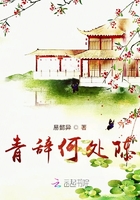It is now easy to understand the full meaning of the term, "the house of Monsieur Grandet,"--that cold, silent, pallid dwelling, standing above the town and sheltered by the ruins of the ramparts. The two pillars and the arch, which made the porte-cochere on which the door opened, were built, like the house itself, of tufa,--a white stone peculiar to the shores of the Loire, and so soft that it lasts hardly more than two centuries. Numberless irregular holes, capriciously bored or eaten out by the inclemency of the weather, gave an appearance of the vermiculated stonework of French architecture to the arch and the side walls of this entrance, which bore some resemblance to the gateway of a jail. Above the arch was a long bas-relief, in hard stone, representing the four seasons, the faces already crumbling away and blackened. This bas-relief was surmounted by a projecting plinth, upon which a variety of chance growths had sprung up,--yellow pellitory, bindweed, convolvuli, nettles, plantain, and even a little cherry-tree, already grown to some height.
The door of the archway was made of solid oak, brown, shrunken, and split in many places; though frail in appearance, it was firmly held in place by a system of iron bolts arranged in symmetrical patterns. Asmall square grating, with close bars red with rust, filled up the middle panel and made, as it were, a motive for the knocker, fastened to it by a ring, which struck upon the grinning head of a huge nail.
This knocker, of the oblong shape and kind which our ancestors called /jaquemart/, looked like a huge note of exclamation; an antiquary who examined it attentively might have found indications of the figure, essentially burlesque, which it once represented, and which long usage had now effaced. Through this little grating--intended in olden times for the recognition of friends in times of civil war--inquisitive persons could perceive, at the farther end of the dark and slimy vault, a few broken steps which led to a garden, picturesquely shut in by walls that were thick and damp, and through which oozed a moisture that nourished tufts of sickly herbage. These walls were the ruins of the ramparts, under which ranged the gardens of several neighboring houses.
The most important room on the ground-floor of the house was a large hall, entered directly from beneath the vault of the porte-cochere.
Few people know the importance of a hall in the little towns of Anjou, Touraine, and Berry. The hall is at one and the same time antechamber, salon, office, boudoir, and dining-room; it is the theatre of domestic life, the common living-room. There the barber of the neighborhood came, twice a year, to cut Monsieur Grandet's hair; there the farmers, the cure, the under-prefect, and the miller's boy came on business.
This room, with two windows looking on the street, was entirely of wood. Gray panels with ancient mouldings covered the walls from top to bottom; the ceiling showed all its beams, which were likewise painted gray, while the space between them had been washed over in white, now yellow with age. An old brass clock, inlaid with arabesques, adorned the mantel of the ill-cut white stone chimney-piece, above which was a greenish mirror, whose edges, bevelled to show the thickness of the glass, reflected a thread of light the whole length of a gothic frame in damascened steel-work. The two copper-gilt candelabra which decorated the corners of the chimney-piece served a double purpose: by taking off the side-branches, each of which held a socket, the main stem--which was fastened to a pedestal of bluish marble tipped with copper--made a candlestick for one candle, which was sufficient for ordinary occasions. The chairs, antique in shape, were covered with tapestry representing the fables of La Fontaine; it was necessary, however, to know that writer well to guess at the subjects, for the faded colors and the figures, blurred by much darning, were difficult to distinguish.
At the four corners of the hall were closets, or rather buffets, surmounted by dirty shelves. An old card-table in marquetry, of which the upper part was a chess-board, stood in the space between the two windows. Above this table was an oval barometer with a black border enlivened with gilt bands, on which the flies had so licentiously disported themselves that the gilding had become problematical. On the panel opposite to the chimney-piece were two portraits in pastel, supposed to represent the grandfather of Madame Grandet, old Monsieur de la Bertelliere, as a lieutenant in the French guard, and the deceased Madame Gentillet in the guise of a shepherdess. The windows were draped with curtains of red /gros de Tours/ held back by silken cords with ecclesiastical tassels. This luxurious decoration, little in keeping with the habits of Monsieur Grandet, had been, together with the steel pier-glass, the tapestries, and the buffets, which were of rose-wood, included in the purchase of the house.
By the window nearest to the door stood a straw chair, whose legs were raised on castors to lift its occupant, Madame Grandet, to a height from which she could see the passers-by. A work-table of stained cherry-wood filled up the embrasure, and the little armchair of Eugenie Grandet stood beside it. In this spot the lives had flowed peacefully onward for fifteen years, in a round of constant work from the month of April to the month of November. On the first day of the latter month they took their winter station by the chimney. Not until that day did Grandet permit a fire to be lighted; and on the thirty-first of March it was extinguished, without regard either to the chills of the early spring or to those of a wintry autumn. A foot-warmer, filled with embers from the kitchen fire, which la Grande Nanon contrived to save for them, enabled Madame and Mademoiselle Grandet to bear the chilly mornings and evenings of April and October.















